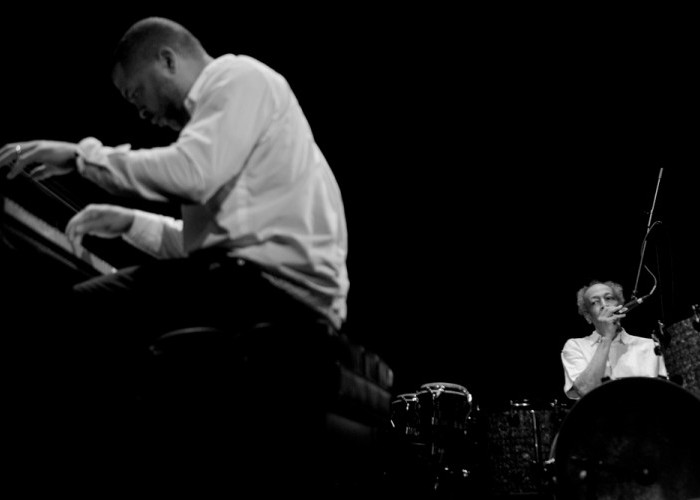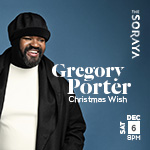Oct 28, 2025 10:47 AM
In Memoriam: Jack DeJohnette, 1942–2025
Jack DeJohnette, a bold and resourceful drummer and NEA Jazz Master who forged a unique vocabulary on the kit over his…

Pianist Jason Moran and percussionist Milford Graves perform as a duo during the Big Ears Festival, which ran March 22–25 in Knoxville, Tennessee.
(Photo: Eli Johnson)With every annual installment, the Big Ears Festival feels more and more like several festivals under a single banner.
If someone only were interested in a steady diet of contemporary classical music, for example, the 2018 edition offered terrific performances by International Contemporary Ensemble, as well as a slew of concerts by Bang on a Can All-Stars, Brooklyn Rider, Nief-Norf and David Behrman, while global music aficionados could check out Niger’s Tal National, Cyro Baptista, Innov Gnawa and Anoushka Shankar.
But that segregated outlook misses the genius of the festival, which is about cross-pollination. Few festivals in the United States, let alone the world, program such a broad array of cutting-edge artists across all genres.
The modular notion of poly-stylistic collaboration affords numerous constellations of musicians from a single pool of talent. The singular keyboardist Craig Taborn, for example, performed in four different ensembles during the festival, leading his own corkscrewing quartet in one of the final Big Ears concerts, after working within groups led by reedists Roscoe Mitchell and Evan Parker, and playing in the collective quartet Rocket Science.
Guitarist and singer Arto Lindsay delivered an electrifying concert with his rhythmically seething working band. Two kit drummers—Kassa Overall and Cinque Kemp—produced massive, yet buoyant, polyrhythms expertly threaded by the muscular, probing bass lines of long-time anchor Melvin Gibbs. Lindsay’s own jagged, noise-encrusted guitar sound sculptures added to the deceptively organized maelstrom, offset by the most sensual of vocal deliveries, with the singer referencing the sensual coo of bossa nova as a beacon of order. The next day, Lindsay brought his same tools to a beautifully pitched duo with Norwegian drummer Paal Nilssen-Love—who played the previous night in The Thing. The rapport between the musicians was remarkable, with the drummer dialing down his free-ranging, thunderous instincts. Still, Nilssen-Love refused to muffle his personality, unleashing ferocious energy and splattering his attack with quick-blind asides.
Rather than succumb to the onslaught or compete with it, Lindsay masterfully located specific dance rhythms within the drummer’s blitz, moving his body to illustrate patterns that most of the audience wouldn’t pick up on otherwise. While unleashing curdled spasms of low-end grind on his guitar, skittering and hovering over the beats, Lindsay slipped into lyric reveries, dreamily intoning standards like “Talk To Me,” “Let’s Get Lost,” as well as the Al Green classic “Simply Beautiful.” Rarely do performers turn sonic violence so convincingly into something romantic.
Pianist Jason Moran also was busy during the festival, leading his raucous Fats Waller Dance Party at a midnight show. But his pair of intimate daytime performances were among the most gripping of the weekend.
The pianist played a first-time duet with the legendary percussionist Milford Graves—who also turned in a solo set and was the subject of Jake Meginsky’s acclaimed documentary Full Mantis—that allowed the packed house at the Bijou Theatre to discover new threads within the core of each musician. Graves isn’t easy to play with—his polymetric attack, emphasis on low-end richness and surging energy demands astute listening and imagination from his partners. I shut my eyes a few times, and it sounded like there were actually two or three different drummers on stage. Yet Moran was more than able to find ways in. In fact, unlike many of the musicians who spend their time struggling to keep up with Graves, the pianist pulled off a dazzling trick by focusing one of their improvisations on hushed, lyric playing—spare, harmonically lush and patient—which in turn brought a rarely heard side of Graves’ genius, allowing him to generate a glowing murmur from his customized kit.
The next afternoon, Moran convened a trio under the name Bangs with cornetist Ron Miles and guitarist Mary Halvorson. The pianist joked that the troupe had existed for six years, but its Big Ears appearance was only its fourth performance. The intimacy and interaction of the players certainly hasn’t suffered from inactivity.
“Cupid,” a gorgeous ballad by the cornetist, sparkled with lapidary clarity, as each complementary line generated a beautifully cumulative mosaic that hung weightless in the air; the guitarist’s “White Space” played up the chamber-like vibe of the trio.
That adventurousness and openness extended to all stripes of music at Big Ears: erudite Vermont folkie Sam Amidon made internal connections to free jazz and noise within his charming set alongside percussionist Shahzad Ismaily and saxophonist Sam Gendel, and Norwegian chanteuse Susanna (née Susanna Wallumrød) connected AC/DC, composer Henry Purcell, Southern folk icon Elizabeth Cotten and Leonard Cohen within a gorgeously refined sound, constructed by harp, fiddle and accordion virtuosos. Susanna was joined on a number of songs by Bonnie “Prince” Billy, shadowing her refined vocals with a touch of rustic soul, a collision of high and low that summed up on the fest’s wonderfully inclusive spirit. DB

Jack DeJohnette boasted a musical resume that was as long as it was fearsome.
Oct 28, 2025 10:47 AM
Jack DeJohnette, a bold and resourceful drummer and NEA Jazz Master who forged a unique vocabulary on the kit over his…

D’Angelo achieved commercial and critical success experimenting with a fusion of jazz, funk, soul, R&B and hip-hop.
Oct 14, 2025 1:47 PM
D’Angelo, a Grammy-winning R&B and neo-soul singer, guitarist and pianist who exerted a profound influence on 21st…

To see the complete list of nominations for the 2026 Grammy Awards, go to grammy.com.
Nov 11, 2025 12:35 PM
The nominations for the 2026 Grammy Awards are in, with plenty to smile about for the worlds of jazz, blues and beyond.…

Jim McNeely’s singular body of work had a profound and lasting influence on many of today’s top jazz composers in the U.S. and in Europe.
Oct 7, 2025 3:40 PM
Pianist Jim McNeely, one of the most distinguished large ensemble jazz composers of his generation, died Sept. 26 at…

Drummond was cherished by generations of mainstream jazz listeners and bandleaders for his authoritative tonal presence, a defining quality of his style most apparent when he played his instrument unamplified.
Nov 4, 2025 11:39 AM
Ray Drummond, a first-call bassist who appeared on hundreds of albums as a sideman for some of the top names in jazz…






